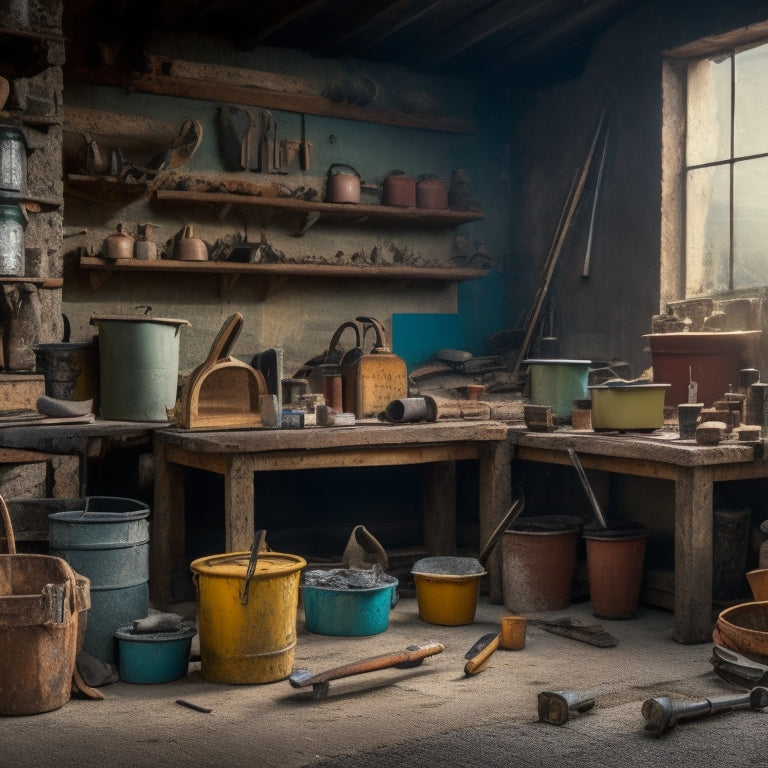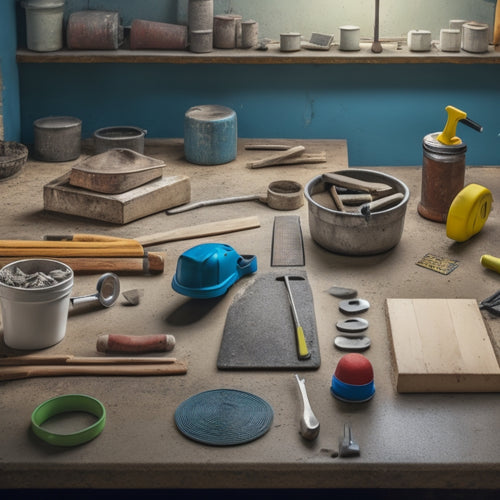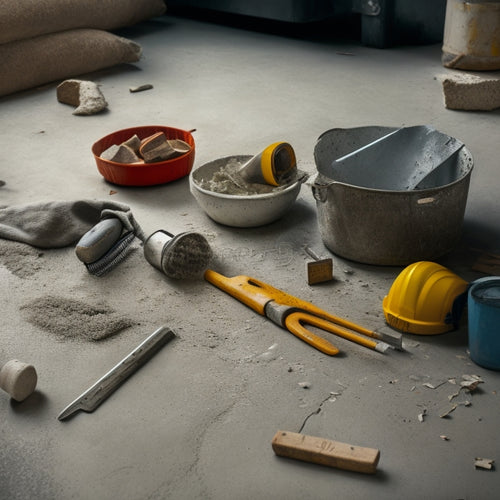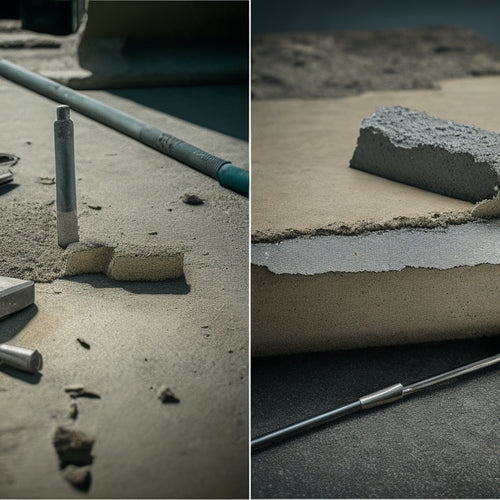
What Tools Do You Need for Concrete Masonry
Share
When tackling a concrete masonry project, you'll need a range of tools to guarantee a professional-grade finish, structural integrity, and your safety on the job site. Crucial hand tools include trowels, jointers, and edgers, while a drill and mixer combo, block saws, and tamping tools are essential power tools. Don't forget safety gear like eye protection, gloves, and steel-toed boots, as well as mixing and measuring tools for accurate concrete proportions. From block laying and leveling tools to mortar and grout application tools, and specialized tools for unique situations, having the right equipment will make all the difference - and you're just getting started on uncovering what you need to know.
Key Takeaways
• Essential hand tools for concrete masonry include trowels, jointers, and edgers for creating clean joints and precise edges.
• Power tools like drill and mixer combos, block saws, and tamping tools are required for efficient concrete masonry work.
• Safety gear and protective equipment, including eye protection, personal protective apparel, and knee pads, are crucial for preventing injuries.
• Mixing and measuring tools, such as mixing buckets, measuring tapes, and slump cones, ensure accurate proportions for concrete.
• Specialized tools like radius trowels, joint profilers, and curved edgers are necessary for unique situations and intricate designs in concrete masonry.
Essential Hand Tools for Masonry
You'll need a set of vital hand tools to efficiently lay and finish concrete masonry, including trowels, jointers, and edgers that are specifically designed for masonry work. These hand tools will help you achieve a professional-looking finish and guarantee that your concrete masonry project is done correctly.
A thorough masonry toolkit should include a range of trowels, such as pointing trowels, finishing trowels, and notched trowels, each designed for a specific task. Jointers and edgers are also essential for creating clean, precise joints and edges.
Proper hand tool maintenance is equally important to guarantee the longevity of your tools and the quality of your work. Regularly clean and inspect your tools to prevent rust and damage. Store them in a dry, protected area to prevent exposure to the elements.
Power Tools for Cinder Block Work
When you're working with cinder blocks, you'll need power tools that can efficiently cut, mix, and finish the concrete.
You'll be using a drill and mixer combo to prepare the mortar, block saws and cutters to shape the blocks, and tamping and finishing tools to guarantee a smooth, even surface.
Drill and Mixer Combo
A drill and mixer combo is a versatile power tool that streamlines cinder block work by efficiently drilling anchor holes and mixing mortar in a single, time-saving operation. This powerful tool is a must-have for any serious mason, as it saves time and energy on the job site. With a drill and mixer combo, you can tackle a variety of tasks with ease, from drilling precise holes to mixing large batches of mortar.
To get the most out of your drill and mixer combo, keep the following tips in mind:
-
Regularly follow drill maintenance tips to guarantee peak performance and extend the life of your tool.
-
Refer to a mixer troubleshooting guide if you encounter any issues with your mixer.
-
Always use the correct drill bits and mixing paddles for your specific project.
-
Keep your workspace clean and organized to avoid accidents and improve efficiency.
-
Practice proper safety protocols when operating your drill and mixer combo to avoid injuries.
Block Saws and Cutters
Block saws and cutters, essential power tools for cinder block work, enable you to make precise cuts and shape blocks efficiently, streamlining your workflow and enhancing overall project quality.
These tools allow you to execute various cutting techniques, such as straight cuts, bevel cuts, and curved cuts, with accuracy and control.
When selecting a block saw or cutter, consider the type of blade you'll need. A diamond-coated blade is ideal for cutting through dense materials, like concrete blocks, while a carbide-tipped blade is better suited for softer materials, like brick.
The blade's size and arbor configuration also impact its performance, so choose a tool that accommodates your specific needs.
Tamping and Finishing
Finish your cinder block project with precision and finesse by utilizing the right tamping and finishing power tools, which help you achieve a professional-grade finish and guarantee structural integrity.
To master tamping techniques and finishing methods, you'll need the following essential tools:
-
Plate compactors: These heavy-duty tools deliver high-frequency vibrations to compact and settle the concrete, ensuring a solid foundation for your project.
-
Hand tampers: Ideal for smaller areas or tight spaces, hand tampers provide precise control for achieving a smooth, even finish.
-
Power trowels: These versatile tools are perfect for finishing large areas, allowing you to achieve a high-polish finish or a textured pattern.
-
Floats: Used for finishing and smoothing out the surface, floats help remove excess material and create a uniform appearance.
-
Edgers: Designed for precision trimming and shaping, edgers help you create clean lines and defined edges.
Safety Gear and Protective Equipment
As you prepare to work with concrete masonry, you'll need to prioritize your safety above all else.
You're about to handle heavy, abrasive materials that can cause serious harm, so it's essential you wear the right gear to protect yourself.
You'll want to focus on eye protection essentials, such as goggles or safety glasses, and personal protective apparel like gloves, long sleeves, and pants to prevent skin damage and injury.
Eye Protection Essentials
You must wear impact-resistant goggles or safety glasses with a snug, comfortable fit to protect your eyes from flying debris and concrete particles. This is a vital aspect of eye protection, as even a small mistake can lead to serious eye injuries. When working with concrete masonry, it's important to prioritize your eye safety above all else.
Here are some key considerations for effective eye protection:
-
Safety glasses: Look for glasses with a wraparound design and soft, padded frames for maximum comfort and protection.
-
Face shields: Consider wearing a face shield in addition to safety glasses for added protection against chemical splashes and flying debris.
-
Anti-fog coatings: Verify your safety glasses or goggles have an anti-fog coating to maintain clear vision in humid or wet conditions.
-
Scratch-resistant lenses: Opt for lenses with scratch-resistant coatings to maintain their integrity over time.
-
Regular cleaning: Regularly clean your safety glasses or goggles to prevent the buildup of dirt and debris that can compromise their effectiveness.
Personal Protective Apparel
When working with concrete masonry, donning the right personal protective apparel is essential to preventing injuries and ensuring a safe working environment. You'll need gear that protects you from head to toe, so let's break it down.
| Protective Gear | Purpose |
|---|---|
| Safety Helmets | Protect your head from falling debris and tools |
| Protective Gloves | Prevent cuts, abrasions, and crush injuries to hands |
| Steel-Toed Boots | Safeguard your feet from heavy objects and tools |
| Knee Pads | Reduce strain and bruising on your knees |
| Dust Mask | Filter out dust and debris from the air you breathe |
Mixing and Measuring Tools Needed
Essential to the concrete masonry process, mixing and measuring tools guarantee accurate proportions and a strong final product. You'll need these tools to ensure your concrete mixture is properly proportioned and mixed, resulting in a durable and long-lasting structure.
To achieve ideal mixing techniques and measuring accuracy, you'll require the following tools:
-
A mixing bucket or wheelbarrow to combine and mix the concrete ingredients
-
A mixing stick or trowel to thoroughly mix and blend the materials
-
A measuring tape or scale to accurately measure the ingredients
-
A mixing paddle or drill with a mixing bit to efficiently mix large quantities
-
A slump cone to test the concrete's workability and consistency
Block Laying and Leveling Tools
With the concrete mixture prepared, it's time to focus on laying and leveling the blocks, a process that requires precision and accuracy to guarantee a structurally sound and visually appealing finish.
As you begin, you'll need a few essential tools to confirm ideal block alignment techniques. A spirit level and a straightedge will help you achieve perfectly horizontal and vertical courses. A string line and line pins will allow you to maintain consistent spacing between blocks, while a block hammer and jointer will help you tap blocks into place and adjust their position as needed.
To confirm ideal mortar ratios, you'll need a mortar scoop or trowel to apply the correct amount of mortar to each block. A level and a square will also come in handy when checking the block's position and alignment.
By using these tools, you'll be able to achieve a professional-looking finish and a structure that's built to last. Remember to work methodically, taking your time to confirm each block is properly aligned and level before moving on to the next one.
With practice and attention to detail, you'll master the art of block laying and leveling.
Mortar and Grout Application Tools
You'll need to master the use of specialized tools to efficiently apply mortar and grout, ensuring a strong bond between blocks and a visually appealing finish. To achieve this, you'll require the following essential tools:
-
Mortar hawk: A long-handled tool with a flat, rectangular blade, used to scoop and spread mortar onto blocks.
-
Grout float: A rubber-topped tool used to spread grout between blocks, removing excess material and creating a smooth finish.
-
Grout sponge: A porous sponge used to remove excess grout from the surface of blocks, helping to achieve a clean finish.
-
Tuck pointer: A tool used to remove excess mortar from between blocks, creating a neat and tidy joint.
-
Mortar mixer: A tool used to mix mortar to the correct consistency, ensuring the right mix of water and cement for your specific mortar type.
Cleaning and Finishing Tools Required
To achieve a professional-looking finish, clean and remove excess mortar and grout from the surface of your concrete masonry project using specialized cleaning and finishing tools.
You'll need a wire brush, stiff-bristled broom, or scrub brush to remove excess mortar and grout. For more thorough cleaning, use a pressure washer or acid-based cleaners, but be cautious not to damage the surface.
For finishing touches, you'll require a set of trowels, floats, and edgers to smooth out the surface and create a uniform texture. Use a pointing trowel to fill gaps and a finishing trowel to create a smooth finish. Edgers help you achieve clean, defined edges.
Mastering cleaning techniques is essential to achieve a professional finish. Experiment with different tools and techniques to develop your skills.
Remember to always follow safety guidelines and manufacturer instructions when using cleaning and finishing tools. By having the right tools and techniques, you'll be able to add the perfect finishing touches to your concrete masonry project.
Specialized Tools for Unique Situations
Delicate or complex concrete masonry projects often require specialized tools that can tackle unique situations, such as curved or irregularly shaped surfaces, corners, or joints.
When you're working on a project that demands advanced masonry techniques, you'll need tools that can adapt to unique project considerations.
To guarantee you're fully equipped, consider adding the following specialized tools to your arsenal:
-
Radius trowels: For smoothing and finishing curved surfaces, such as arches or rounded corners.
-
Joint profilers: For creating consistent, precision-crafted joints in irregularly shaped surfaces.
-
Corner floats: For finishing and smoothing corners, guaranteeing a seamless joint.
-
Curved edgers: For creating clean, precise edges on curved surfaces.
-
Masonry profiling tools: For creating intricate designs and patterns on concrete surfaces.
These specialized tools will give you the precision and control you need to tackle unique project considerations and deliver high-quality results.
Frequently Asked Questions
How Do I Store My Concrete Masonry Tools When Not in Use?
When you're not working on a concrete masonry project, you'll want to store your tools properly to maintain their condition and extend their lifespan.
Designate a dry, organized area for tool storage, and consider investing in a tool chest or pegboard.
Regularly clean and lubricate your tools, and perform routine maintenance tasks, like sharpening and repairing, to keep them in top shape.
Can I Rent Concrete Masonry Tools Instead of Buying Them?
When considering concrete masonry projects, you're likely weighing the cost benefits of buying versus renting tools.
Renting can be a smart choice, especially for infrequent or one-time projects.
Explore rental options for specialized tools like mixers, saws, and tamping equipment.
This approach can greatly reduce upfront costs and minimize storage concerns.
Are There Any Specific Tools for Working With Colored Concrete?
You're about to reveal the secrets of working with colored concrete, but first, let's get one thing straight - you can't just wing it with the same old tools.
For colored concrete mixing, you'll need a precision mixer that won't contaminate the color.
And for colored concrete finishing, specialized trowels and floats with non-reactive materials are a must.
Don't settle for anything less, or your masterpiece will be ruined.
Do I Need to Calibrate My Concrete Masonry Tools Regularly?
You'll need to calibrate your concrete masonry tools regularly to guarantee accuracy and precision.
The calibration frequency depends on usage, but as a rule of thumb, you should calibrate your tools every 1-3 months or after 500-1000 uses.
Proper tool maintenance is essential to extend their lifespan and prevent errors.
Set a schedule to check and adjust your tools to maintain peak performance and achieve professional-grade results.
Can I Use Concrete Masonry Tools for Other Construction Projects?
You're wondering if you can repurpose your concrete masonry tools for other construction projects.
The answer is yes, but with some caveats.
Many tools, like trowels and levels, are versatile enough for other tasks.
However, specialized tools, like those for concrete mixing or specific masonry techniques, mightn't be as adaptable.
Be certain to assess the tool's functionality and adjust your approach accordingly to guarantee precision and control in your new project.
Conclusion
As you stand at the threshold of your concrete masonry project, remember that having the right tools is the master key that opens the gates of success.
With the arsenal of essentials at your disposal, you'll be able to build a foundation as strong as the ancient Pyramids, lay blocks as precise as a Swiss watch, and finish with a finesse that rivals Michelangelo's David.
Now, go forth and construct a masterpiece that will stand the test of time!
Related Posts
-

Must-Have Tools for Laying Concrete Tiles
When laying concrete tiles, you'll need a range of essential tools to get the job done right. Start with subfloor pre...
-

Top 10 Concrete Repair Tools for Small Fixes
You'll need the right tools to tackle small concrete repairs efficiently and effectively. When it comes to small fixe...
-

Top Tools for Concrete Adhesion Success
When it comes to concrete adhesion success, you'll need to wield the right tools and techniques to guarantee a strong...


